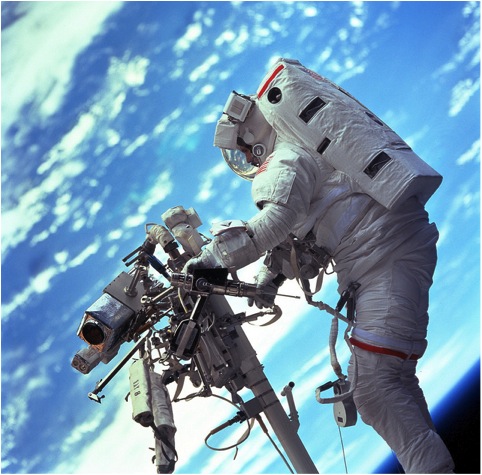Can you imagine taking a trip into outer space?
From Earth to the Outer Limits: A Voyage in Images Can you envision the incredible sights you’d see peering out the window of the Space Shuttle? For most of us space travel will remain just a dream, but it’s still fun to dream! Luckily for us, cameras on satellites, probes and the galactic gaze of giant telescopes provide us with images from the far reaches of the Universe. Let’s allow these pictures to be our windows on to space and have the strange and wonderful images fuel our dreams.
A Countdown and Then Lift Off…

You’ve had years of training, now you’re ready for a mission. 3, 2, 1 – Lift off! You’re on your way into outer space. Can you imagine sitting in the seat as you rocket to the stars? Incredibly, every Space Shuttle mission costs $450 million and requires 835,958 gallons of liquid fuel to launch!
Looking Back At Our Blue Planet

When in space it would be great to look back at planet Earth, which we often take for granted when it’s under our feet! Earth has a unique position in our Solar System, being just the right average distance from the Sun (150 million km) to maintain an atmosphere enabling life to flourish.
An Astronaut at Work

Of course, once you were in space you would need to have a photo taken for your family and friends back home. Here is an astronaut busy at work while orbiting the Earth. It’s certainly not a job for people scared of heights!
Behold Our Moon!

Gaze at this beautifully detailed image of the moon and it’s hard to believe humans have actually walked upon its crater-covered surface! The moon actually gets closer to and further from the Earth during its elliptical orbit, but its average distance from our planet is 384,403 km.
The Fiery Sun

While it would be very unwise to attempt to get a closer look at the Sun in a space rocket, our telescopes regularly provide us with stunning images of the fiery yellow dwarf star. While the Sun’s surface is a scorching 5,600 Celsius, its core is an incredible 150 million Celsius!
The Moon-like Planet Mercury

Mercury has an average distance from the Sun of 57 million km. Unsurprisingly, it has an arid and parched moon-like surface and no substantial atmosphere. The closest Mercury gets to Earth is 77.3 million km.
Beautiful but Deadly Venus

While beautiful to look at, Venus has a deadly atmosphere of noxious gases covered in huge clouds of sulfuric acid. Venus’ average distance from the Sun is 108 million km. At its closest, Venus is 40 million km from Earth.
The Red Planet Mars

Science fiction writers love to imagine visiting Mars, or Martians visiting us! However, we’re still a long way off realising this dream as Mars is 56 million km from Earth when at its closest. Mars has a reddish desert-like surface featuring huge mountains and canyons. Its average distance from the Sun is 228 million km.
The Titanic Gas Giant Jupiter

Jupiter is the largest planet in our Solar System and is mostly made up of billowing liquids and gases. Its famous Great Red Spot is a constantly raging storm which is actually bigger than planet Earth! On average, it is 779 million km from the Sun and when closest to Earth is 588 million km away.
The Rings of Saturn

Saturn is another gas giant, featuring beautiful encircling rings mostly made of water ice that make it one of the most stunning sights in the Solar System. Saturn has an average distance from the Sun of 1.43 billion km. When closest to Earth it is 2.57 billion km away.
Icy Ringed Uranus

While it is one of the gas giants, Uranus is also called an ice giant with its neighbour Neptune and has encircling rings like those of Saturn. It has an average distance from the Sun of 2.88 billion km and is 2.57 billion miles from Earth when closest.
Neptune

Similar in composition to Uranus, Neptune also has rings in addition to featuring an immense Great Dark Spot, similar to Jupiter’s Great Red Spot, which is made up of tempestuous windstorms. The average distance of Neptune from the Sun is 4.5 billion km, while at its closest it is 4.3 billion km from Earth.
The Dwarf Planet Pluto

Poor Pluto is no longer considered a planet, but a dwarf planet, and has an average distance from the Sun of 5.91 billion km. Pluto occupies a region in the Solar System called the Kuiper belt, which contains numerous ice bodies, and at its closest is 4.28 million km from Earth. There is little light around Pluto, making photographs difficult.
A Cluster of Stars

Many light years from our Solar System, there are clusters of stars that shine so brightly our powerful telescopes can capture beautifully powerful images of the most distant regions of the Universe.
Many More Galaxies to Explore…

